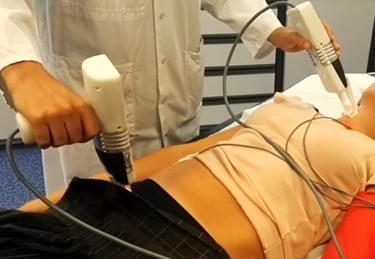Arterial stiffness using Laser Doppler Vibrometry - CARDIS/INSIDE
Background on arterial stiffness and Pulse Wave Velocity (PWV)
Besides transporting blood from the heart to the organs, arteries also play a critical function in buffering the intermittent ejections of blood from the heart and transforming them into a steady and continuous flow at organ level. They can exhibit this function thanks to their composition and micro-architecture with as its most prominent constituents smooth muscle cells and the structural proteins collagen (providing strength) and, particularly, elastin, providing the vessel with the ability to distend under increasing pressure and elastically recoil as pressure reduces, hereby storing elastic energy (the so-called windkessel effect). “Arterial stiffness” is a container term that aims to quantify the stiffness properties of the arterial tree. Due to the distensibility of the arteries, the pressure pulsations generated by the heart propagate as waves over the arterial tree, and the speed of this wave (the so-called Pulse Wave Velocity or PWV, in the order of 4-10 m/s in normal humans) is indicative for the stiffness of the arteries. The stiffer the arteries become – as a consequence of ageing or disease - the faster the wave will propagate and the higher PWV. Numerous studies, see [1] for a review, have demonstrated that elevated arterial stiffness is predictive for cardiovascular events, making it a powerful biomarker with prognostic power above and beyond conventional risk factors (age, sex, blood pressure, cholesterol levels, smoking, …). There are several methods to measure arterial stiffness [2], but the current gold standard is the assessment of PWV from measurements of the arterial pulse in the neck (carotid artery) and groin (femoral artery), yielding carotid-femoral PWV. The concept of “arterial ageing”, and in particular accelerated arterial ageing because of an unhealthy life style or a high blood pressure, is an appealing way to communicate the impact of life style on the cardiovascular system and one of the main goals of the EU-funded COST action network VascAgeNet.
Measuring PWV with Laser-Doppler Vibrometry – CARDIS and INSIDE
Laser-Doppler Vibrometry (or LDV) is a technique whereby the reflection of a laser beam on a moving target is used to assess the velocity of that moving target. With a wavelength in the micrometer range, LDV can measure displacements and velocities with high accuracy. Industrial LDV systems have been used in a.o. automotive industries. In a collaboration with a.o. imec and Medtronic and an international consortium, we received EU-funding for the development of a multi-beam LDV device for clinical use in tow back-to-back funded projects, CARDIS (2015-2020) and INSIDE (2020-2025). Though multi-purpose, one of the main applications of the device is the real-time measurement of carotid-femoral PWV from LDV measurements in the neck and groin. Key expertise for the project is provided by imec and the research team of UGent-professor Roel Baets, world renown expert in integrated silicon photonics. The picture on the right shows a working prototype of the device that was used within CARDIS in a clinical feasibility study at the Hôpital Européen Georges Pompidou in Paris under supervision of prof. Pierre Boutouyrie. Within INSIDE, we will further develop the technology for real-time clinical applications.
References
- Prediction of Cardiovascular Events and All-Cause Mortality With Arterial Stiffness A Systematic Review and Meta-Analysis. Vlachopoulos, C., Aznaouridis K. and Stefanadis C. Journal of the American College of Cardiology 2010, 55:13:1318-1327.
- How to Measure Arterial Stiffness in Humans. Segers P., Rietzschel ER., Chirinos, JA. Arteriosclerosis Thrombosis and Vascular Biology 2020, 40: 5:
IBiTech researchers currently active on the project
Funding sources
- EU-H2020



